Distance: 3.15km
When I first started writing this blog, several parts of the Greenway were yet to be finished and the section of the canal between Sheriff Street and Newcomen Bridge was still being worked on. Thankfully now that section is open with both a path for pedestrians and a cycle-way too, I have updated this post to reflect the opening of the linear park but retain the information about the diversion up Seville Place that I took when I ran the canal.

The first section I will look at here is from the Sea Lock on North Wall Quay at the River Liffey to the 5th Lock at Cross Guns Bridge, a distance of just over 3 kilometers.

While traditionally some could argue that the Royal Canal truly starts at Broadstone or what is now the 5th Lock at Cross Guns Bridge in Phibsborough, the first Lock to be built, let us start where the Royal Canal meets the River Liffey on North Wall Quay.

With our backs to the Liffey we start on the newly completed cycle-way bridge the river side of the Scherzer Lifting Bridges. These lifting bridges, erected in the mid 1930’s were modeled on the slightly older pair at George’s Dock a little further towards the Customs House which where were installed around 1911.
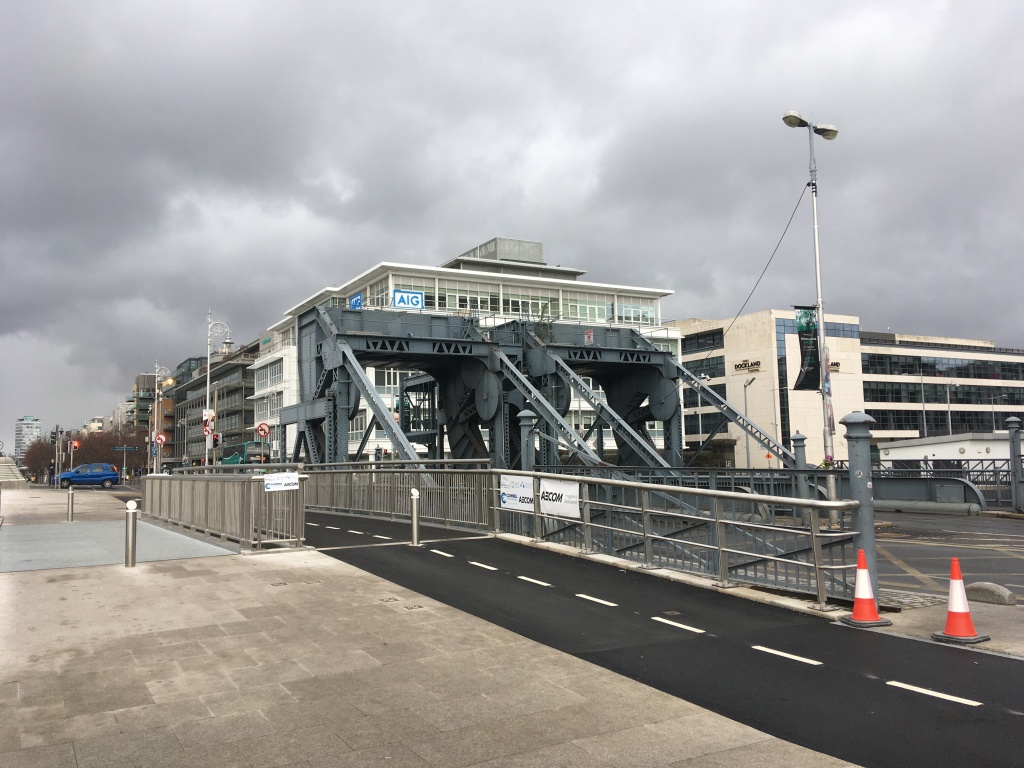
For those seeking to navigate the Royal Canal, the first sight they will see after going under these bridges is the mighty Sea Lock Gates which were installed in 2008. These new gates were designed to reduce the possibility of flooding along the canal banks between the tidal River Liffey and the 1st Lock at Newcomen Bridge.

The first part of our walk takes us up along Guild Street on the Linear Park towards Sheriff Street. We pass over the relatively new Spencer Dock Bridge on Mayor Street which carries the Red Line Luas to the Point Village.

We soon come to the Luke Kelly Head Sculpture. Luke Kelly was a renowned Irish folk musician and member of The Dubliners. He grew up in the Sheriff Street area and is famed for singing The Auld Triangle, a song strongly associated with the Royal Canal. This sculpture and a statue of him on South King Street were both unveiled in early 2019 on the 35th anniversary of his death.

Behind the Luke Kelly statue we come the the Sheriff Street Lifting Bridge which is a reminder of the industrial and commercial past of the Royal Canal in this area around Spencer Dock. Of note on the now inoperable bridge are two commemorative plaques on the east side of the bridge. These plaques have the company crest of the Midlands Great Western Railway (MGWR) Company. The MGWR bought the canal in 1845 and built its railway west along the banks of the canal as far as Ballinea some 90 kilometres west of the Liffey. Both plaques predate the bridge however and were unveiled by John Poyntz Spencer, 5th Earl Spencer, Lord Lieutenant of Ireland for whom the Dock area is named.

As mentioned at the start work is now finished on continuing the linear park and a cycle-way from Sheriff Street to the North Strand Road and opened on 31 July 2020. Before then it was necessary to divert away from the canal and head north up Seville Place as far as the Five Lamps on the North Strand Road. From here you would take a right and head back up to join the Royal Canal at Newcomen Bridge and the 1st Lock.
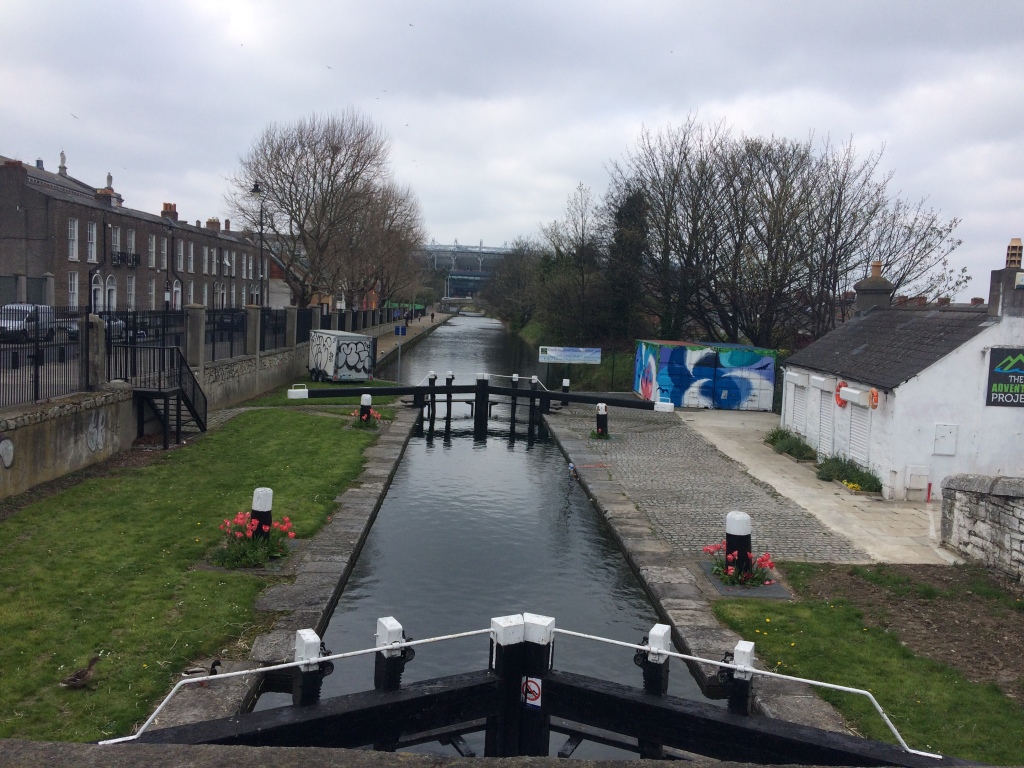
Thankfully it is no longer necessary to leave the bank of the Royal Canal and you can continue straight up to the Railway Bridges that span over the canal and Ossary Road. A total of 5 lines run over these bridges including the lines west to Maynooth and Sligo, the DART lines to Howth and Malahide as well as the lines onto Drogheda, Dundalk and Belfast. The first bridge was built in 1842, the second in 1903 and a later addition to the east carries a maintenance line for washing trains.

Next we come to Effin Bridge which is named so for the difficulty and inconvenience in lifting it to let boats pass. The lifting bridge which carries a railway line over the canal sits on the level of the canal and is only raised several times a year to allow boats to pass. Scheduled lift dates for 2021 have yet to be announced however work has recently taken place by Irish Rail on the bridge replacing the timber under the tracks.

A large ramp now lifts pedestrians and cyclists up from the Railway Bridges over the tracks at Effin Bridge to bring us level with Newcomen Bridge and the 1st Lock at the North Strand Road.

Crossing the North Strand Road and continuing on the south bank we head towards Clarke Bridge. Like with most of the bridges we will encounter as we head west, the original canal bridge would have been built between 1790 and 1810 with an abutted railway bridge added from the 1840’s as the MGWR started laying their tracks. It is also the first bridge we encounter that we can pass under with a towpath accommodated under the bridge. A noticeable feature of both Clarke Bride and Clonliffe Bridge is that it is difficult for the walker to pass under them as the arch appears much lower than other bridges. The reason for this being is that the canal level was raised between the 2nd Lock and the 1st Lock with the building of the railway to North Wall and so the path is now higher than it was when the bridge was originally built. A full explanation of this can be found on page 59 of the late Brian J. Goggin’s book The Royal Under the Railway.
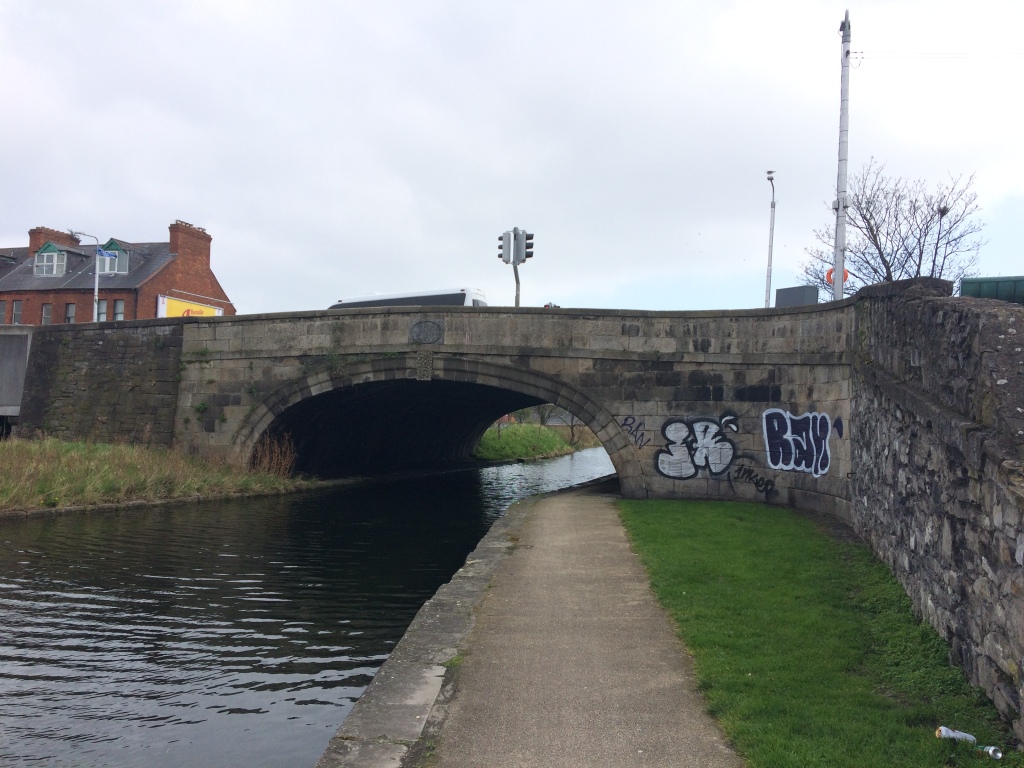
As we come out the west side of Clarke Bridge we are met with the impressive sight of Croke Park, Ireland’s biggest stadium and home of the GAA. The canal passes under what was once known as the Canal End but since 2007 has been known as the Davin Stand, named for the GAA’s first President Maurice Davin.
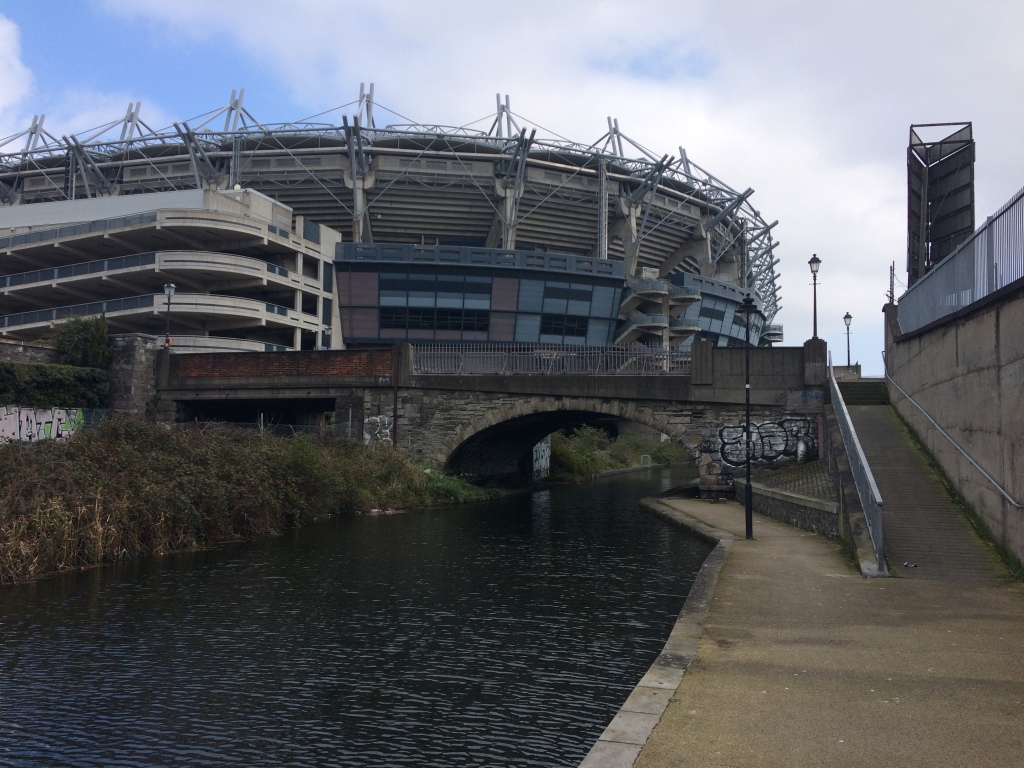
After passing under Croke Park we come to Clonliffe Bridge which carries Russel Street over the canal and the railway. It should be noted that Croke Park has a railway running either side of it. On the Canal End is the railway line to the Docklands Train Station at Sheriff Street and on the Railway End better known as Hill 16 is the railway line into Connolly Train Station.
Only 400 metres from Clonliffe Bridge we come to Binns Bridge and the 2nd Lock, a double chambered lock at Drumcondra and the first of several double chambered locks we will meet. While a large pipe attached to the bridge takes away from its original aesthetic, the double arches of the Railway Bridge make it more appeasing. As we enter the 2nd Lock we now begin a quick ascent up out of the city to the 12th Lock in Castleknock. The canal rises 12 locks in the space of 9 kilometres from the 1st Lock and of these 7 have double chambers.

It us not possible to go under Binns Bridge as so we must rise up to the road level and cross busy Dorset Street while also crossing over to the North Bank of the canal to carry on. As we reach the other side we are greeted by the statue of Brendan Behan who wrote the play The Quare Fellow which opens with a rendition of the previously mentioned The Auld Triangle. It is open to debate as to whether Brendan or his musically talented brother Dominic actually wrote the song itself.

The Quare Fellow is set in Mountjoy Prison which has stood beside the Royal Canal since it opened in 1850 and where Behan himself was incarcerated as an inmate. The sits beside the 2nd Lock it is not long before we reach the 3rd Lock.

The 3rd Lock, 4th Lock and 5th Lock, all double chambered locks come in quick succession and while a person walking or running alongside the canal can make quick progress up this stretch, it takes considerably longer to navigate.
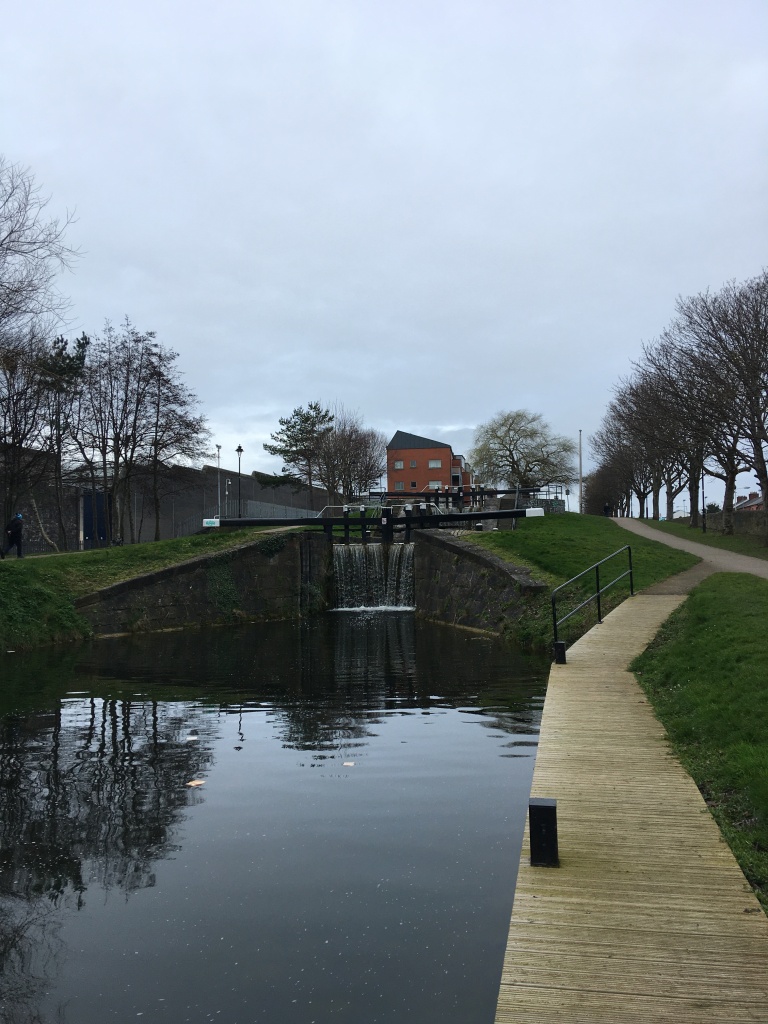
The 4th level of the canal is also the location where the original Broadstone Branch of the Royal Canal came out but has long since been filled in with a linear park running down alongside the prison wall.

The Broadstone Branch is a topic I intend to return to in a different post and will link here when I do. Where the prison car park now stands was once a dry dock for the maintenance and repair of boats.

Before we reach the 5th Lock we must rise up again to meet the Phibsborough Road at Cross Guns Bridge. Originally known as Westmoreland Bridge after the 10th Earl of Westmoreland, Lord Lieutenant of Ireland, who laid the first stone of the original bridge in 1790. The bridge was replaced in the 1860s to help facilitate the building of the short railway tunnel beside it. A video celebrating the 10th Anniversary of the reopening of the canal to navigation can be seen here:
In total we have traveled a little over 3 kilometres from the Liffey so far not including our diversion down Seville Place but here is a good place to stop for a drink or a bit of food at the recently relocated Bernard Shaw pub and EatYard.
Part 2: Cross Guns Bridge to Castleknock
Part 3: Castleknock to Leixlip Confey
Part 4: Leixlip Confey to Maynooth
Part 7: Thomastown to Mullingar Harbour
Part 8: Mullingar to Coolnahay
Part 9: Coolnahay to Ballynacargy Bridge
Part 10: Ballynacargy to Abbeyshrule
Part 11: Abbeyshrule to Ballybrannigan
Part 12: Ballybrannigan to the 41st Lock
Part 13: 41st Lock to Richmond Harbour

10 replies on “Walking on the Royal Canal: North Wall to Cross Guns Bridge”
Nice piece informative and very readable well done !
LikeLike
[…] my last walking post which I have just updated with additional photographs, I left you having a pint and a burger at The […]
LikeLike
[…] Part 1: North Wall to Cross Guns Bridge […]
LikeLike
[…] Part 1: North Wall to Cross Guns Bridge […]
LikeLike
[…] Part 1: North Wall to Cross Guns Bridge […]
LikeLike
[…] Part 1: North Wall to Cross Guns Bridge […]
LikeLike
[…] Part 1: North Wall to Cross Guns Bridge […]
LikeLike
[…] Part 1: North Wall to Cross Guns Bridge […]
LikeLike
[…] Part 1: North Wall to Cross Guns Bridge […]
LikeLike
[…] Part 1: North Wall to Cross Guns Bridge […]
LikeLike